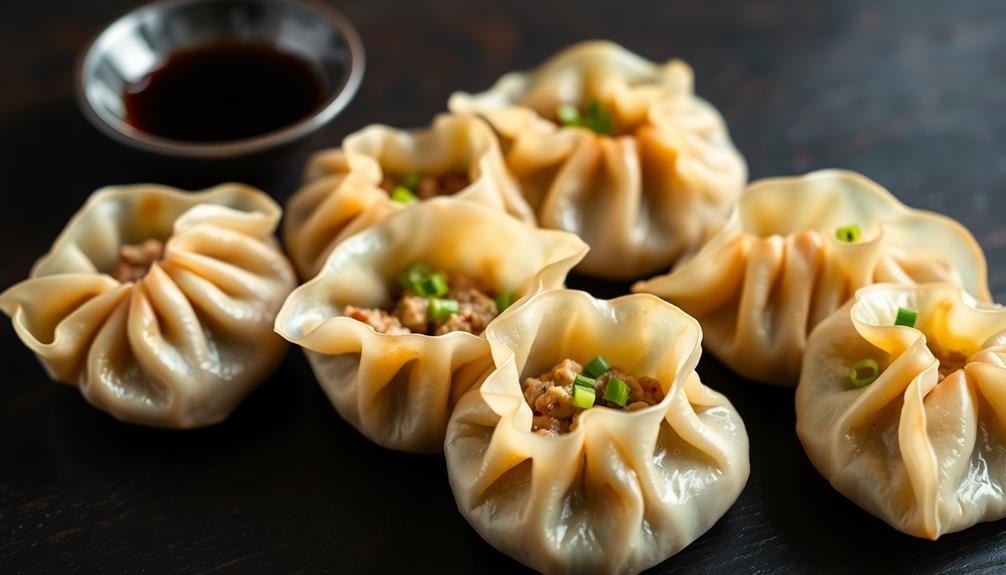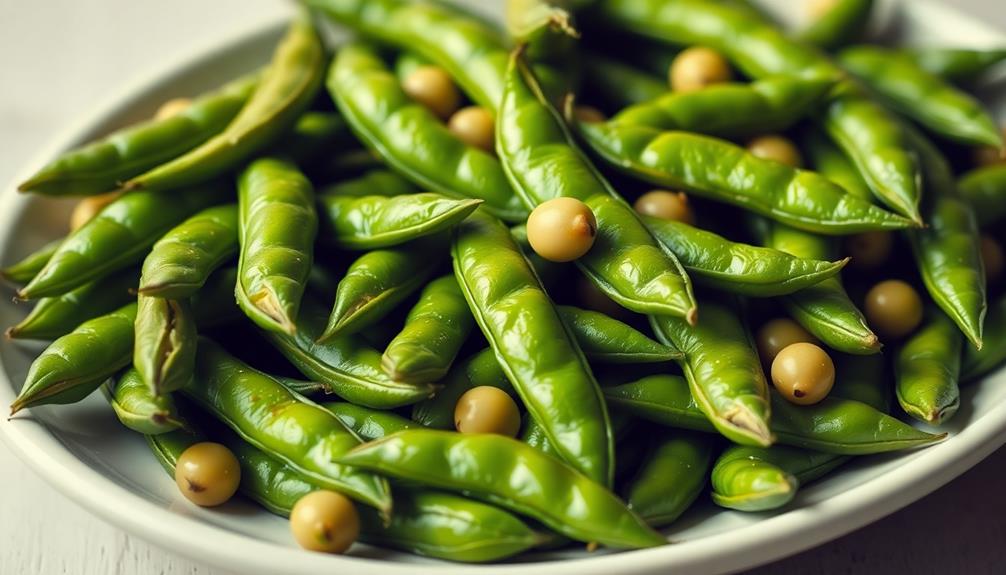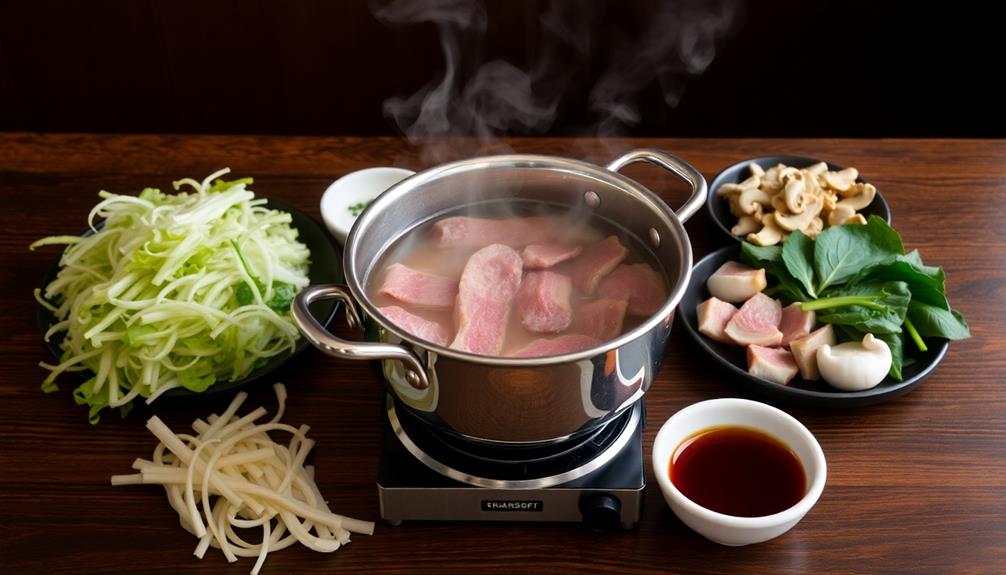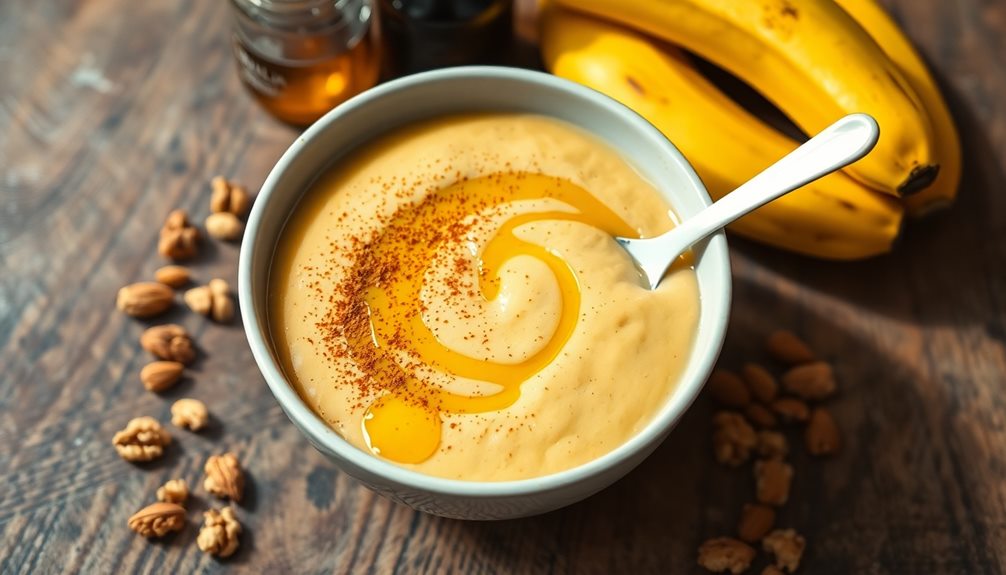Gyoza, the beloved Japanese dumpling, holds a special place in the hearts and palates of many. Its history, though rooted in Chinese jiaozi, has evolved into a quintessential part of Japanese cuisine. Whether you're hosting a gathering or craving a savory snack, these delectable dumplings offer a world of flavor waiting to be explored. From the crisp exterior to the juicy interior, the perfect gyoza is a harmonious balance of textures and tastes. So, what are you waiting for? Dive into the captivating world of these dumplings and discover why they've become a cherished culinary delight.
Key Takeaways
- Gyoza originated from Chinese jiaozi, introduced to Japan in the 7th century, and later adapted with a thinner skin and different fillings.
- Japanese-style gyoza gained popularity in the post-WWII era due to American influence, leading to various regional adaptations and fusion recipes.
- Gyoza are commonly pan-fried, steamed, or boiled, and served as appetizers or side dishes, often with dipping sauces like soy sauce and rice vinegar.
- Typical gyoza fillings include ground pork, cabbage, garlic, ginger, and scallions, with vegetarian options using mushrooms, tofu, and vegetables.
- Gyoza are a staple in Japanese cuisine, representing the fusion of Chinese and Japanese culinary traditions and are increasingly popular in Western countries.
History
Gyoza, the beloved Japanese dumplings, trace their origins back to the Chinese jiaozi, which were first introduced to Japan in the 7th century.
Over the centuries, Japanese chefs adapted the recipe, creating a distinct dumpling with a thinner skin and a savory, umami-rich filling. Today, gyoza come in a variety of shapes and flavors, from the classic pork and cabbage to creative vegetarian options.
The preparation of gyoza is an art form, requiring precise folding techniques to create the distinctive crescent shape. Families often gather to make gyoza together, passing down the secrets of their perfect pleating.
Whether pan-fried, steamed, or boiled, the satisfying texture and flavor of gyoza have made them a beloved part of Japanese cuisine and culture.
Recipe
Gyoza, or Japanese dumplings, are a beloved appetizer or side dish that combines delicate wrapper and flavorful filling. These pan-fried pockets of goodness aren't only delicious but also surprisingly easy to make at home.
The key to perfect gyoza lies in the balance of the filling. A mixture of ground pork, finely chopped cabbage, green onions, and a blend of savory seasonings create a harmonious flavor profile that complements the thin, delicate wrapper.
Ingredients:
- 1 lb ground pork
- 1 cup finely chopped cabbage
- 3 green onions, finely chopped
- 2 cloves garlic, minced
- 1 tablespoon grated ginger
- 1 tablespoon soy sauce
- 1 teaspoon sesame oil
- 1/2 teaspoon salt
- 1/4 teaspoon white pepper
- 30-40 gyoza wrappers
To cook, heat a large non-stick skillet over medium-high heat and add a tablespoon of oil. Place the gyoza in the pan, flat side down, and cook for 2-3 minutes until the bottoms are golden brown.
Then, add 1/4 cup of water to the pan, cover, and steam the gyoza for 5-7 minutes, or until the wrappers are translucent and the filling is cooked through.
Remember to resist the urge to overstuff the gyoza, as this can lead to leakage during cooking. Additionally, be gentle when handling the delicate wrappers to prevent tearing.
Serve the gyoza hot, with your favorite dipping sauce on the side, and enjoy the perfect balance of crispy, chewy, and savory flavors.
Cooking Steps
First, gather your filling ingredients and mix them together.
Next, wrap the filling into the gyoza wrappers, sealing them tightly.
Then, sear the gyoza in a skillet before steaming them until they're cooked through.
Step 1. Gather Filling Ingredients
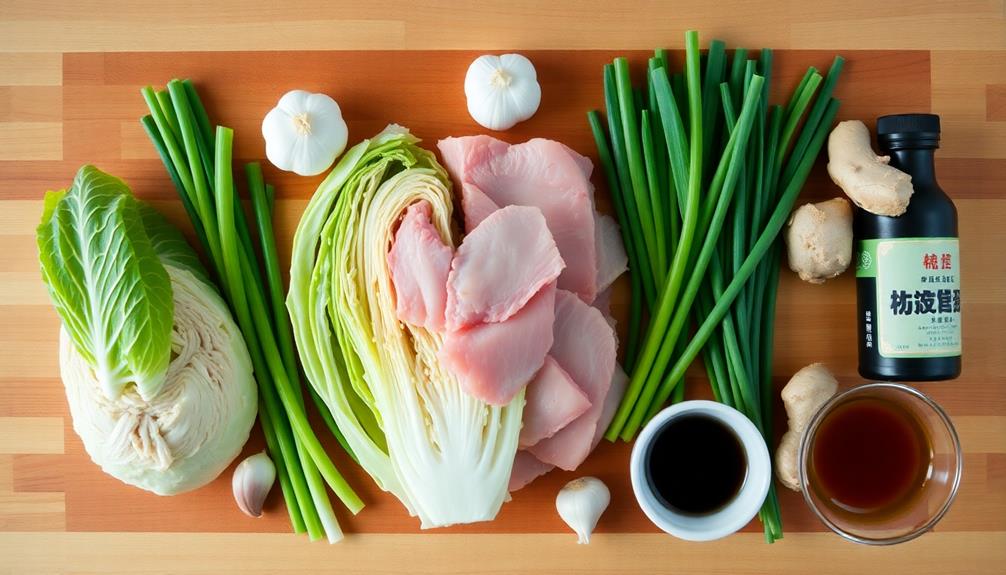
Gather the filling ingredients next. You'll need ground pork, cabbage, green onions, garlic, ginger, soy sauce, sesame oil, and white pepper. Once you have all the filling ingredients gathered, it’s time to start preparing the filling for the dumplings. The ground pork, cabbage, green onions, garlic, and ginger will combine to create a flavorful and savory filling, while the soy sauce, sesame oil, and white pepper will add depth and complexity to the flavors. As an added bonus, the health benefits of miso soup, such as its probiotic properties and high nutrient content, make it a great addition to any meal.
Finely chop the cabbage and green onions, then mince the garlic and ginger. In a large bowl, combine the ground pork, chopped cabbage, green onions, garlic, and ginger. Season the mixture with soy sauce, sesame oil, and white pepper. Mix everything together until the filling is well combined.
Grab a spoon and scoop about 1-2 tablespoons of the filling onto the center of a gyoza wrapper. Wet the edges of the wrapper with water, then fold the wrapper in half and crimp the edges to seal.
Repeat this process with the remaining wrappers and filling.
Now you're ready to cook the gyoza! Place a skillet over medium heat and add a bit of oil. Arrange the gyoza in the pan, making sure they're not touching. Cook until the bottoms are golden brown, then add a splash of water, cover, and steam until the wrappers are tender.
Step 2. Wrap Filling in Gyoza Wrappers

Grab a spoon and scoop about 1-2 tablespoons of the filling onto the center of a gyoza wrapper.
Fold the wrapper in half, pressing the edges to seal. Use your fingers to crimp and pleat the edges, creating a half-moon shape. Be sure to leave no gaps, as you don't want the filling to leak out during cooking.
Now, heat a large skillet over medium-high heat and add a drizzle of oil. Gently place the wrapped gyoza in the pan, flat side down.
Cook for 2-3 minutes until the bottoms are golden brown. Pour in a splash of water, cover the pan, and let the gyoza steam for another 3-5 minutes until the wrappers are tender and the filling is cooked through.
Serve your homemade gyoza hot, with dipping sauce on the side. Enjoy the delicious combination of savory filling and chewy wrapper in every bite!
Step 3. Sear Gyoza in Skillet
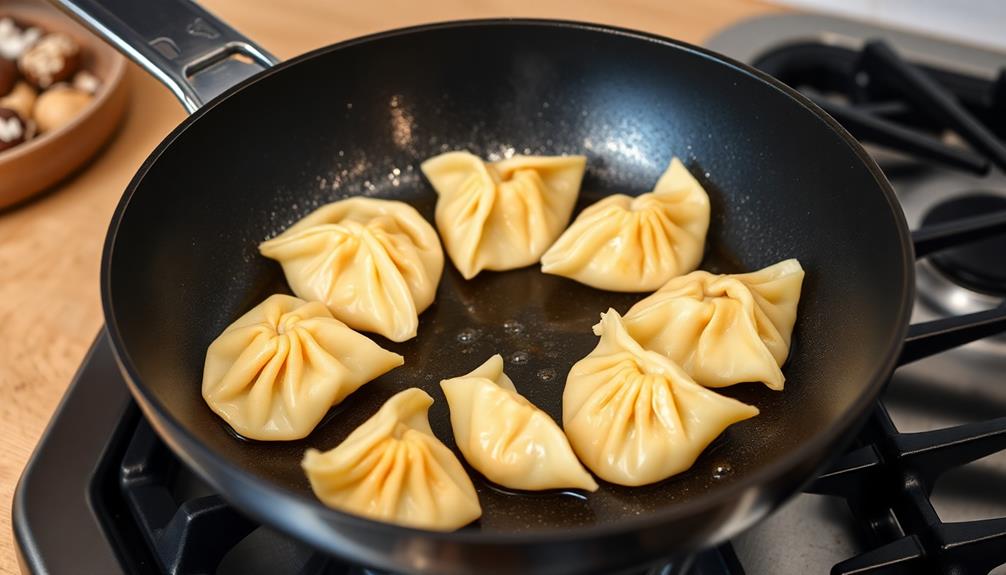
Now that you have the gyoza neatly wrapped, it's time to sear them in the skillet.
Heat a large skillet over medium-high heat and add a couple of tablespoons of vegetable oil. Once the oil is hot, carefully add the gyoza to the pan, ensuring they don't touch each other. Let them sear for 2-3 minutes, or until the bottoms are golden brown and crispy.
Next, add about 1/4 cup of water to the pan and quickly cover it with a lid. This will create steam to cook the tops of the gyoza. Let them steam for 3-5 minutes, or until the wrappers are tender and translucent.
Remove the lid and continue cooking for another minute or two, allowing the bottoms to crisp up again.
Carefully transfer the seared gyoza to a serving plate and enjoy them hot, with your choice of dipping sauce on the side.
Step 4. Steam Gyoza

After searing the gyoza, it's time to steam them. Grab a large skillet with a tight-fitting lid. Add about 1/4 cup of water to the pan, being careful not to splash the gyoza.
Place the lid on the skillet and turn the heat to medium-high. As the water begins to boil, the steam will cook the gyoza from the top, making them soft and tender.
Steam the gyoza for about 5-7 minutes, peeking occasionally to make sure the water doesn't evaporate completely. When the gyoza are cooked through, the wrapper will be translucent and the filling will be hot.
Carefully remove the lid, allowing the steam to escape. Use tongs to transfer the steamed gyoza to a serving plate. Serve hot, with your favorite dipping sauces on the side.
The combination of seared and steamed textures makes for an irresistible gyoza experience. Enjoy your freshly cooked dumplings!
Step 5. Serve Gyoza With Dipping Sauce
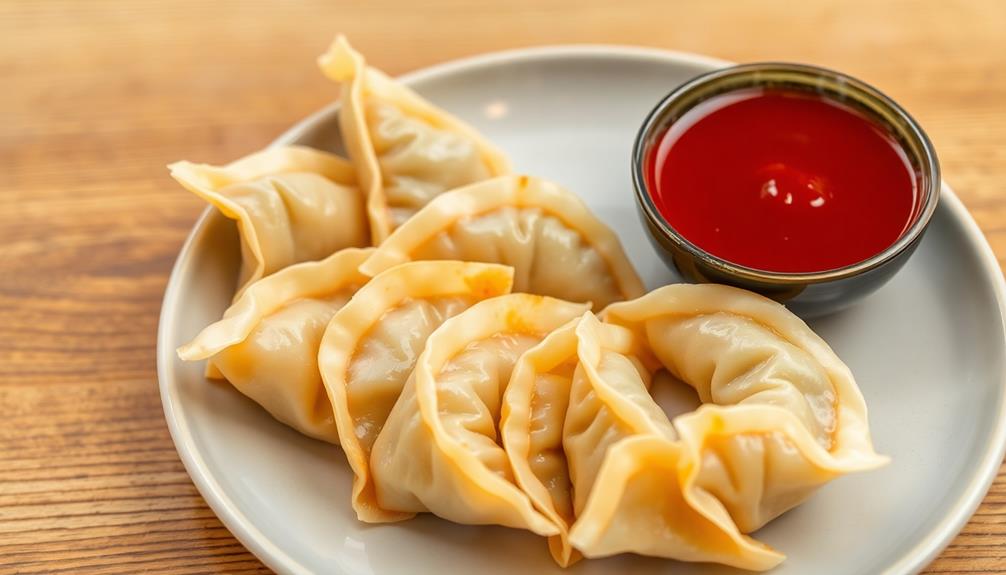
The gyoza are now ready to be served with your desired dipping sauces. To prepare the dipping sauce, combine soy sauce, rice vinegar, and a touch of sesame oil in a small bowl. You can also add a pinch of sugar and chili oil for some extra flavor.
Serve the gyoza hot, arranging them on a platter or individual plates. Encourage your guests to dip the gyoza in the sauce, savoring the contrast of the crispy bottoms and the tender, juicy filling.
For a fun presentation, you can serve the sauce in small dishes alongside the gyoza. This allows everyone to customize their dipping experience to their taste.
Don't be afraid to experiment with different dipping sauce recipes – the possibilities are endless!
Enjoy your delicious homemade gyoza, and don't forget to savor every bite. The combination of the pillowy dumplings and the flavorful dipping sauce is simply irresistible.
Final Thoughts
Gyoza, those delicate dumplings, have captured the hearts and taste buds of many. As you've learned, creating these pockets of flavor takes some practice, but the effort is well worth it.
Whether you prefer the classic pork filling or experiment with new ingredients, the joy of biting into a perfectly crisp-yet-tender gyoza is unparalleled.
While the dipping sauce is a crucial component, don't be afraid to get creative. Try different flavor profiles, like a zesty ponzu or a spicy-sweet chili oil.
Pair the gyoza with a refreshing green salad or steamed vegetables for a well-rounded meal.
Ultimately, the beauty of gyoza lies in its simplicity. These humble dumplings are a testament to the power of quality ingredients and skilled preparation.
